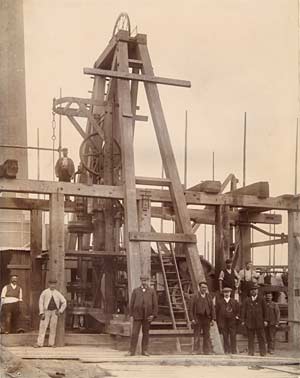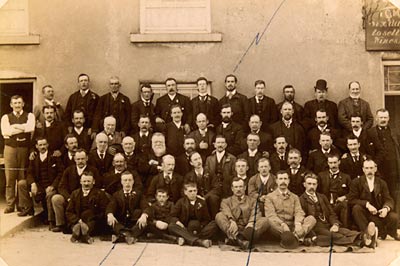City of Nottingham Water Department, 1852-1978
Until 1845 Nottingham's water supply was in the hands of a number of small private companies.
The oldest, the [Old] Nottingham Waterworks Company , was established in 1696 and extracted water from the River Leen. In the early nineteenth century this company erected new works at Scotholme in Basford and at Brewhouse Yard under Nottingham Castle.
The Nottingham New Waterworks Company , or the Northern Waterworks, was set up in 1824 in North Sherwood Street to serve the north-eastern past of the town.
Two years later, the Trent Waterworks Company was established. Its engineer, Thomas Hawksley (1807-1893) , built innovative waterworks at Trent Bridge, inaugurated in 1831, which extracted water from the River Trent, filtered it, and pumped it under constant high pressure to taps situated in streets and courts.
A fourth company, the Zion Hill Water and Marble Works , was established around 1790 and raised water from two wells near Alfreton Road and Canning Circus, Nottingham. It had ceased to function independently by 1824.
Following the Nottingham Water Act of 1845, the three companies were merged into one body known as the Nottingham Waterworks Company . Thomas Hawskley remained as its engineer until 1880. In 1879 the Nottingham Improvement Act was passed, which empowered the Nottingham Corporation (the town council) to take over responsibility for water supplies. The water undertaking was fully transferred to the new Nottingham Corporation Waterworks on 14 May 1880.

Photograph of the Butterley Well at the Boughton Works, 20 March 1905 [R/HR/1/8/1/33]
In 1880, there were five waterworks supplying water to the Nottingham area: the Scotholme Works, the Trent Works, the Park or Sion Hill Works on The Ropewalk (opened 1850), Bagthorpe Works at Haydn Road in Basford (opened 1857), and Bestwood Works in Bestwood Park (opened 1874). The last three, engineered by Hawksley, extracted water from the sandstone beds lying underneath Nottingham. Nottingham Corporation's Municipal Engineer, M. Ogle Tarbotton (1835-1887), designed an additional water pumping plant at Papplewick which opened in 1884. At this point, the Scotholme, Trent, and Brewhouse Yard works were closed. A borehole pumping station at Burton Joyce was opened in 1898, and the Boughton Works in 1901.
However, these advances were not enough to satisfy the demand of the growing city of Nottingham for water supplies. In 1899, the Derwent Valley Water Act was passed, allowing the Derwent Valley Water Board to construct reservoirs in the upper Derwent Valley in Derbyshire. See the related collection of records relating to the Derwent Valley Water Board, 1899-1974 (DVW).
The Nottingham Corporation Waterworks became the City of Nottingham Water Department in 1912, but this was no more than a change of name. Five further borehole stations, at Rufford, Lambley, Halam, Markham Clinton and Ompton, were built between 1945 and 1969.
In 1974 the newly formed Severn Trent Water Authority assumed responsibility for supplying the region with water. The last meeting of the Water Committee of the City Council was held on 11 March 1974.
Records
A single minute book of the Northern Waterworks Company survives (MS 880) and covers the period 1827-1845. It commences with a list of subscribers and minutes of committee meetings and gives much detail over the introduction of water supplies to the north eastern portion of the city.
The main bulk of the records were transferred to the University Library from the Hucknall Road Office of the Lower Trent Division of the Severn Trent Water Authority in separate deposits between September 1987 and September 1988. Multi-level descriptions of these records are available through the Manuscripts Online Catalogue. The catalogue was enhanced in 2011-2012 with support from The National Archives Cataloguing Grant Programme.
Most of the records relate to the Nottingham Corporation Waterworks and the City of Nottingham Water Department (in existence 1880-1974). Although a few earlier documents have survived, there are no official records of the Nottingham Waterworks Company or its predecessors beyond a small series of annual accounts dated 1852-1856. Likewise, there is only a very small amount of material from the Severn Trent Water Authority's ownership of the waterworks, dated 1974-1975 and this material has now been transferred to join other records of the Severn Trent Water Authority.
Other records in the collection relate to the supply of water in central Nottinghamshire and the sewerage system of Nottingham. There are some records (mainly plans) from the Central Nottinghamshire Water Board (1965-1969), Newark upon Trent Waterworks (1889-1959), Borough of Mansfield Water Department (1958-1965), Sutton in Ashfield Urban District Council (1949-1963) and Sheffield Regional Hospital Board (1963-1966).
The collection is composed chiefly of maps and plans. These are primarily technical drawings showing, for example, sections of pipes and sewers, routes of pipes, geological sections, reservoir construction, pumping machinery etc. Many of the plans are hand drawn. All are important in reflecting the development of systems for supplying water and the provision of a sanitary sewerage system, from the age of pioneering engineers such as Thomas Hawksley to more recent years.
The collection also includes the minutes of various committees, Engineers' Reports, Accounts, and a large number of Ordnance Survey Sheets. Many of the latter have been annotated to show routes of water mains etc.
Material from uncatalogued or partly catalogued accruals of maps, plans and photographs are being added to the online catalogue.
There is also a related collection of plans of Papplewick Pumping Station, 1879-1947 (PPS )

Employees photographed at the Water Department Annual Outing, c.1890 [R/HR/1/8/1/70]
Next page: Stoke Bardolph Sewage works and Bulcote Model Farm, 1892-1975